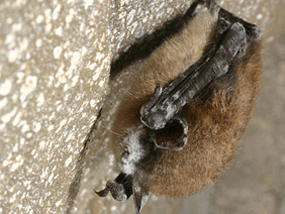|
You are viewing ARCHIVED content published online before January 20, 2025.
Please note that this content is NOT UPDATED, and links may not work. For current information,
visit https://www.nps.gov/aboutus/news/index.htm.
Contact: Mary Shew, National Park Service, Resource Management Specialist, 256-845-9605 Contact: Ann Froschauer, US Fish & Wildlife Service, National White-nose Syndrome Communication Leader, 413-253-8536

Al Hicks, NY Dept. of Environmental Conservation
Russell Cave National Monument
White-Nose Syndrome Confirmed in Park Bats Russell Cave National Monument has detected the presence of white-nose syndrome (WNS) in the Russell Cave system, in Jackson County, Alabama. National Park Service and Alabama A&M scientists conducted a survey of the Russell Cave system and observed bats that appeared to have the telltale white patches that indicate possible white-nose syndrome. Suspect tricolor bats were submitted to the Southeast Cooperative Wildlife Disease Study (SCWDS), where lab results confirmed the disease. This is the first confirmed finding in the state. "The park has taken steps to help prevent the spread of this disease that is so devastating to bat populations throughout the East," said Park Superintendent, John Bundy. "Although the cave has been closed for more than ten years I am pleased to report that the archeological site remains open at this time and visitors should not be impacted in any way." White-nose syndrome is a disease caused by the fungus Geomyces destructans and is responsible thus far for the deaths of over 5.5 million bats in eastern North America. First discovered in a New York cave in February 2006, the fungus has spread rapidly – having been detected west into Oklahoma, north into Canada, and south to North Carolina. The fungus thrives in cold and humid conditions typical of those found in caves and mines in which many bat species hibernate. The disease got its name from the white fungal growth which can be seen around the muzzles, ears, and wing membranes of affected bats, typically during their hibernation. Bats with WNS appear to use up their precious fat reserves too quickly to stay in hibernation through the winter. The fungus is transmitted from bat to bat, but long distance, sudden leaps of the fungus are believed to have been facilitated by human activities. Thus far there are no cures for the disease which does not seem to affect humans or other animals. Scientists are cautious about applying any fungicide treatments in caves or mines which could risk disrupting delicate subterranean ecosystems. Before WNS, bats have been long-lived small mammals with average life spans of about 20 years; some little brown bats have been documented to live over 40 years! Though long-lived, bats reproduce slowly with each mother having only one pup per year. If bat populations ever recover to pre-WNS levels, it will take many years. Bats are a vital part of our ecosystem and their rapid decline could be noticed directly by humans. Bats can consume up to half their body weight in insects in just one night; one little brown bat may catch 600 mosquitoes per hour! To do your part to help, always adhere to local, state, and federal cave advisories and closures to help prevent the movement of WNS by humans. For your own safety (and the bats') never enter abandoned mines. If you see dead bats or bats that appear sick within the park, do not pick them up – instead report them to park headquarters at (256) 495-2672. Suggested websites to learn more about bats and WNS are: US Fish and Wildlife Service – www.fws.gov/WhiteNoseSyndrome/ USGS Fort Collins Science Center -- www.fort.usgs.gov/WNS/ Bat Conservation International -- www.batcon.org/ |
Last updated: April 14, 2015
